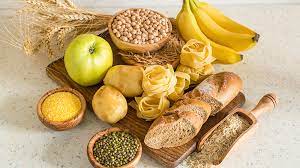Carbohydrates
Carbohydrates are the organic compounds i.e. essential biomolecules composed of carbon ,hydrogen and oxygen. The hydrogen and oxygen are in the ratio of 2:1 so they are also called "Hydrates of C...

Proteins are the most complex chemical compounds formed of C,H,O,N (sometimes S and P)
The characteristic element of protein is nitrogen. Proteins are the polymers of amino acids made up of large numbers of amino acids linked together chemically.
Amino acids are linked together by the peptide bond. Peptide bond is formed by the union of the alpha carboxyl group (-COOH) of an amino acid with the alpha amino group (-NH2) of another amino acid and the molecule of water is eliminated.
This union of amino acids is known as a peptide linkage.

Structure of protein
Based on the organization of protein, they have four different structures.
Primary structure

It is the basic, temporary and first formed structure. In this structure, amino acids are linked together only by peptide bonds. They are linear in structure. Insulin is the smallest protein which shows primary structure.
Secondary structure
The secondary structure of protein is formed from primary structure due to the the formation of hydrogen bonds.
Hydrogen bonds are formed between O of one amino acid and H of another amino acid.
Types of secondary structure
1)Alpha helical structure

In this structure linear polypeptide changes into spiral shape. Hydrogen bond is formed between O of carboxylic (-CO) group of one amino acid to H of amino group(-NH) of fourth amino acid of the same polypeptide chain, for example: keratin of hair and fibrin of blood.
2)Beta Pleated structure

In Beta pleated structure, two or more polypeptide chains are connected by intermolecular hydrogen bonds .
A sheet of polypeptide chain produced
is called beta pleated sheet. For example : silk fiber, ribonuclease
Tertiary structure

Tertiary structures are formed by twisting and folding of alpha helix to form a three dimensional structure.
They are linked by hydrogen bonds, ionic bonds, disulphide bonds, hydrophobic interactions and Vander Waals interaction. For example myoglobin (muscle) ,albumin (egg).
Quaternary structure

This is the most complex structure of proteins . Quaternary structure is formed by the two or more similar or dissimilar polypeptide chains. These polypeptide chains are linked by hydrogen bonds, disulphide bonds, ionic bonds and hydrophobic interactions. For example: hemoglobin has quaternary structure which consists of four polypeptide chains (two alpha and two beta).